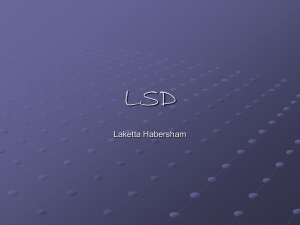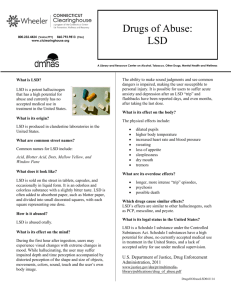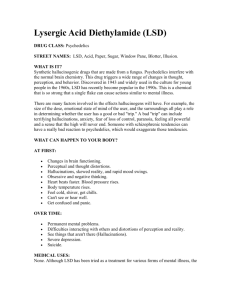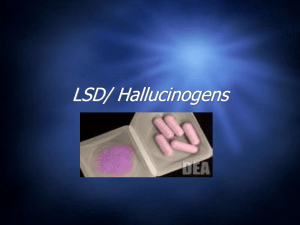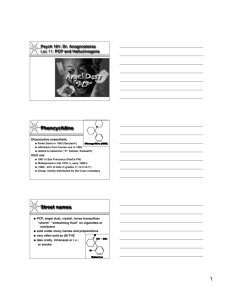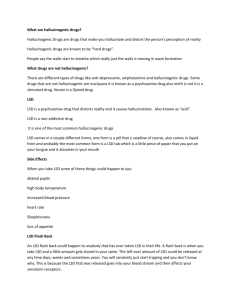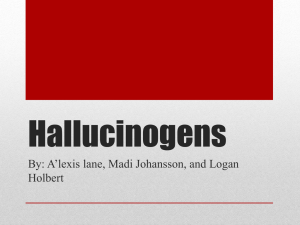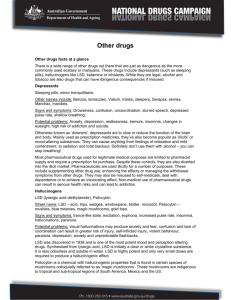LSD - Lycaeum
advertisement
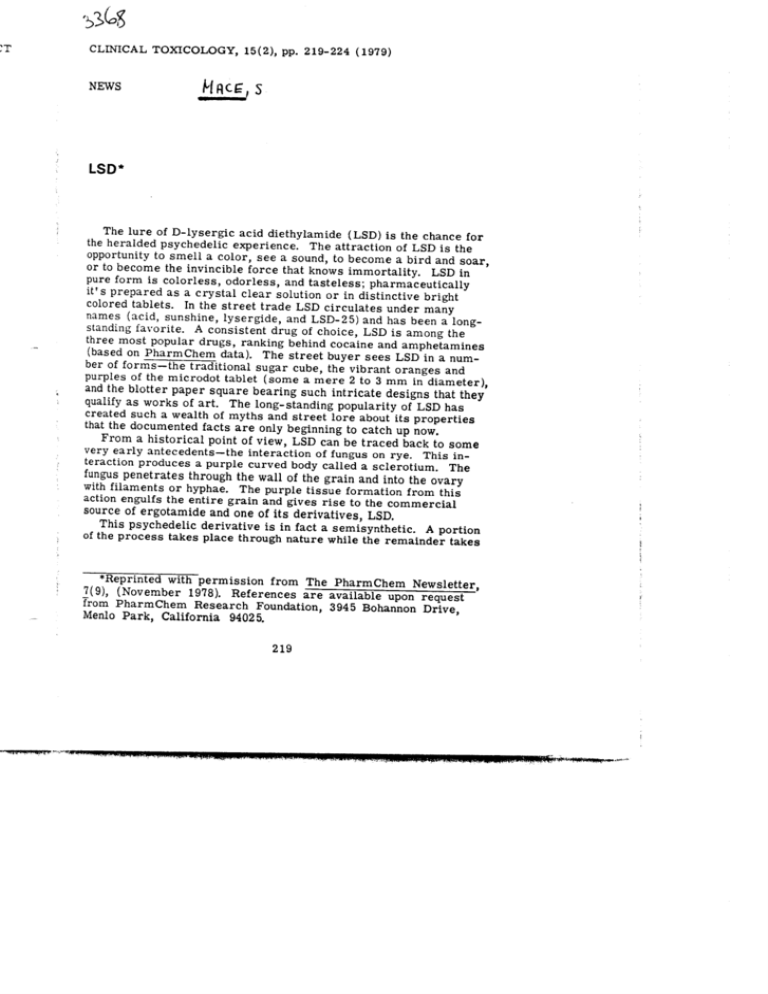
CLINICAL TOXICOLOGY, :T 15(2), pp. 219-224 (1979) s LSD* i - : .: The lure of D-lysergic acid diethylamide (LSD) is the chance for the heralded psychedelic experience. The attraction of LSD is the opportunity to smell a color, see a sound, to become a bird and soar, or to become the invincible force that knows immortality. LSD in pure form is colorless, odorless, and tasteless; pharmaceutically it's prepared as a crystal clear solution or in distinctive bright colored tablets. In the street trade LSD circulates under many names (acid, sunshine, lysergide, and LSD-25) and has been a longstanding favorite. A consistent drug of choice, LSD is among the three most popular drugs, ranking behind cocaine and amphetamines (based on PharmChem data). The street buyer sees LSD in a number of forms--the traditional sugar cube, the vibrant oranges and purples of the microdot tablet (some a mere 2 to 3 mm in diameter), and the blotter paper square bearing such intricate designs that they qualify as works of art. The long-standing popularity of LSD has created such a wealth of myths and street lore about its properties that the documented facts are only beginning to catch up now. From a historical point of view, LSD can be traced back to some very early antecedents--the interaction of fungus on rye. This interaction produces a purple curved body called a sclerotium. The fungus penetrates through the wall of the grain and into the ovary with filaments or hyphae. The purple tissue formation from this action engulfs the entire grain and gives rise to the commercial source of ergotamide and one of its derivatives, LSD. This psychedelic derivative is in fact a semisynthetic. A portion of the process takes place through nature while the remainder takes *Reprinted with permission from The PharmChem Newsletter, 7(9), (November 1978). References are available upon request from PharmChem Research Foundation, 3945 Bohannon Drive, Menlo Park, California 94025. 219 220 NEWS NEWS place in the laboratory. It was in the Sandoz Laboratory in Switzerland that LSD first came into existence through the mind and hands of Dr. Albert Hofmann. Dr. Hofmann noted that "LSD was not just the fruit of a chance discovery, but the outcome of a more complex process. It had its beginning in a definite concept and was followed by appropriate experiments." Although first synthesized in 1938, it wasn't until 1943 that actual experimentation on this new drug was undertaken. S t r u c t u r e. D-Lysergic acid diethylamide has a number of associated structures which are a rearrangement of the base structure. These analogs are lysergamide (C_6HI6N202). The structure for the hallucinogen LSD-25 is very like these analogs. The empirical formula, C2oH25N30, makes it quite clear that it is the number of atoms in the structure which is the basis for its designation There are two lysergic acid diethylamide isomers which edly different effects. These isomers, D and L, are mirror each other. The D isomer of LSD (see Fig. 1) is the active producing hallucinogenic and psychedelic effects. The figure 5-HI: Serotonin [ (5-hydroxytrypta monoamine oxidasc / hydrogen as LSD-25. have markimages of substance depicts 5-hydroxyindolcacetic acid (5-HIAA) FIGURE (N-a 2 the structure of D-LSD with the structure rotated to the right. The other isomer, L-LSD or iso-LSD, is only slightly reactive when compared to D-LSD, its structure is rotated to the left. Dosage and andEffect. The action of LSD-25 in the human body antagonist (opposing action). Experime antagonists blocked both LSD and 5-HT potent agonist at 5-HT receptors. , This . has been analyzed ulus property. The normal metabohc p; understand the nature of this action. At tonin is normally broken down into two and two specific sites of action identified. Primar- ily, the serotonergic neuronal system (5-HT), a nerve cell receptor site in the central nervous system, is responsible for the reaction to LSD. On a lesser scale, the Dopamine or DA receptors cause a minimal, almost nonexistent reaction. Some researchers have also claimed aof stereospecific for serotonergic D-LSD as well. However, weight current evidencereceptor supportssite the neuronal systemthe and its action, Kuhn, White, and Appel made a study in September of 1977 on the action of LSD using rats as the study organism. These researchers employed an agonist/antagonist line of experimentation to determine at which site LSD-25 acts. By using various substances they were able to determine if the effect was an agonist (prime mover) or an N F_ - H L-_CO'N(C2Hs)2 FIG. 1. D-Lysergic droxyindolacetic acid and melatonin (Fi Conversion of 5-HT to 5-HIAA is ac( raphe nuclei. This nucleus is two contil of gray matter, composed of nerve cell_ tion of the central nervous system. Thi visual, and sensory outputs. LSD stimu nuclei which lends to its peculiar prope: LSD are structural analogs; they are ch lar structure but differ in respect to a c If LSD does block serotonin-5-HT re. in quantities that are effective at the 5-1 the physical-psychological reaction that is due to a decrease in the rate of firing --an effective blockade but with NH I CH3 acid diethylamide of 5-HT MO (LSD, LSD-25). FIG. 3. Serotonin (5-hydrox_tryptam C_ NEWS 221 5-HT: Serotonin (5-hydroxytryptamine)-present monoamine oxidase in the body N-acetyl 5-HI 1- 5-hydroxyindoleacetic (5-HIAA) !5. kf acid Melatonin (N-acetyl-5-methoxytryptamine) FIGURE2 ._ ed ht s antagonist (opposing action). Experimental data showed that 5-HT antagonists blocked both LSD and 5-HT receptors. Also, LSD is a potent agonist at 5-HT receptors. This shows a discriminatory stimulus property. The normal metabolic pathway must be considered to understand the nature of this action. At this 5-HT receptor site, serotonin is normally broken down into two separate substances: 5 hydroxyindolacetic acid and melatonin (Fig. 2). Conversion of 5-HT to 5-HIAA is accomplished via firing of dorsal raphe nuclei. This nucleus is two contiguous and similar structures of gray matter, composed of nerve cells, found in the posterior portion of the central nervous system. This area is responsible for mood, visual, and sensory outputs. LSD stimulates 5-HT but not the raphe nuclei which lends to its peculiar properties. Serotonin (Fig. 3) and LSD are structural analogs; they are chemical compounds with a similar structure but differ in respect to a certain component. If LSD does block serotonin-5-HT reaction and it is administered in quantities that are effective at the 5-HT receptor, this would explain the physical-psychological reaction that LSD possesses. This reaction is due to a decrease in the rate of firing of neurons in the raphe nuclei --an effective blockade of 5-HT but with smaller doses of LSD. At HO_ N_ CH2.CH2. NH 2 FIG. 3. Serotonin (5-hydroxytryptamine). _.l_.,_',,',_._,'_ - _,..._ CZ_ =. __ , n_,,_z_.._ _._.._m._.t__-m._._ ,.,_ 222 NEWS larger doses the 5-HT is stimulated, but decreased firing is still observed. As a side effect of the experiment by Kuhn, White, and Appel, they found psilocybin and mescaline mimicked LSD, but of course not to the same extent or potency. The interaction of LSD-25 and the 5-HT pathway produces the blockage of normally occurring phenomena with a much more potent substance, The appropriate dosage for LSD-25 is an often debated topic which includes such street variables as potency and purity. The Journal of the American Medical Association gives a dosage of 1 microgram per kilogram of body weight for an encounter of short duration and 4 micrograms per kilogram of body weight for a longer encounter. A person weighing between 160 and 180 lb, ingesting 288 to 324 micrograms, would be receiving a high dose. When a dose is sufficiently low and repeated over an undefined period (specific for each person), a tolerance may develop. This means that there is a state of increasing resistance to the usual effects of the drug as a result of prior exposure, Murray, Graigmill, and Fischer, in a study on the effects of LSD and mescaline on rats, hypothesized that there are two classes of action in the living organism to account for tolerance. One class was pharmacological tolerance (including tissue tolerance) which is how the body handles a given drug. Metabolism, malabsorption, and excretion are all properties that affect this action. Also involved is the desensitization of the target tissue which is affected by LSD-25. The other mechanism affecting response is behavioral tolerance. In order to function, an organism compensates for the drug-induced state. This is a learned ability to orient one' s self while in a state of disorientation. The study showed that when higher doses were employed, it took longer before tolerance effects were evident. The actual lethal dosage for LSD is still an unanswered question. Various data have been collected on the matter but none are conclusive. It seems, based on experimental data, that the reaction to LSD-25 is a function that varies in each individual (as is the case with the majority of drugs, licit or illicit), A d v e r s e E f f e c t s. There has been continuing concern as to the long-range effects of LSD on the human body. The most notable concerns have been the possibility of recurrent flashbacks and genetic damage to the chromosomes. Flashbacks are spontaneous recurrences of the LSD experience after the immediate effect of the drug has worn off. This reaction can be triggered by a sensation similar to one experienced during the drug-induced high. An interesting study was conducted by Naditch and Fenwick which produced significant information about user-flashback relationships. Some 235 male LSD users were studied seeking correlations in personalities, usage, and pertinent experiences. Flashbacks proved most prevalent among users characterized by more primary process, less reality oriented thinking, and defenses such as repression and regression. There was also a high relationship in such characteristics as less total coping capacity, less NEWS tolerance of ambiguity, external locus of c disorder. A higher usage rate corresponc traits could also contribute to a flashback an adverse reaction experiences a panic a tially alter neurochemical balances within ego capacity flashbacks could occur at a h: it's indicated that for some people the incJ rises as adverse experiences increase. Recently there has been speculation tha chromosome damage than is produced by r_ difficult to make any correlation between d users since nutrition and incidence of vira: ports of chromosomal breakage are still u_ their medical significance has not been full tions understood. One effect that has been the increased incidence of spontaneous abo fects. There is some historical support to fect. People ingesting rye that had been at1 enced adverse reactions. This type of ergo "St. Anthony's Fire" and one of the adverst of pregnancies. It is quite possible that the LSD has something in common with i_s prec Street LSD. The LSD-erabegan in of Dr. Timothy Leafy and others, significar Within a short period of time this drug bec_ if least understood, illicit drugs. The wide. was due in part to the unequaled profit avail A home chemist could easily produce for 1C sell for $10.00 on the illicit market. The lu ed to those seeking easy profit or a powerfu trained psychiatrists sought a therapeutic u: conducted experiments. In the 13 years sire notoriety is such that anyoneeven slightlyf_ of LSD. Any drug purchased in the illicit market sort. The purchaser is entirely in the hand_, the dealer. Any given sample may be pure I thesized chemical compound pretending to b, street drug like LSD is the product of home home manufacturer, s skill or lack thereof. bears directly on such vital questions as dos the dealer introduces such concerns as impo LSD or adulterants being used to stretch a s_ A tally of samples submitted to PharmCh_ tion of the alleged contents versus actual co_n Table 1 reflect samples from the first two m 1972 to 1978. A tota2 of 534 samples was su_ S NEWS tolerance 1, : r ro- _. s e _r is _k ge lC 2es "n )n- )n ci 5s 223 of ambiguity, external locus of control, and more thought disorder. A higher usage rate corresponding to these personality traits could also contribute to a flashback syndroms. A person with an adverse reaction experiences a panic anxiety state that could potentially alter neurochemical balances within the body, and with a lesser ego capacity flashbacks could occur at a higher rate. From this study it's indicated that for some people the incidence of flashbacks also rises as adverse experiences increase. Recently there has been speculation that LSD may cause no more chromosome damage than is produced by many common drugs. It is difficult to make any correlation between drug users and nondrug users since nutrition and incidence of viral infection vary. The reports of chromosomal breakage are still under consideration, and their medical significance has not been fully explored nor the implications understood. One effect that has been observed in pregnancies is the increased incidence of spontaneous abortion, but not of birth defects. There is some historical support to account for this side effect. People ingesting rye that had been attacked by a fungus experienced adverse reactions. This type of ergot poisoning was called "St. Anthony' s Fire" and one of the adverse effects was termination of pregnancies. It is quite possible that the semisynthetic compound LSD has something in common with its precursor. Street LSD. The LSD-era began in 1965 and, with the advocacy of Dr. Timothy Leary and others, significantly affected our culture. Within a short period of time this drug became one of the best known, if least understood, illicit drugs. The widespread availability of LSD was due in part to the unequaled profit available to the manufacturers. A home chemist could easily produce for 10t something that could sell for $10.00 on the illicit market. The lure of LSD wasn't restricted to those seeking easy profit or a powerful hallucinogenic drug; trained psychiatrists sought a therapeutic use and even the U.S. Army conducted experiments. In the 13 years since LSD came of age, its notoriety is such that anyone even slightly familiar with drugs knows of LSD. Any drug purchased in the illicit market is a gamble of the worst sort. The purchaser is entirely in the hands of the manufacturer and the dealer. Any given sample may be pure LSD-25 or a poorly synthesized chemical compound pretending to be the real thing. An illicit street drug like LSD is the product of home chemistry and reflects the home manufacturer' s skill or lack thereof. The skill of the chemist bears directly on such vital questions as dose and purity. The role of the dealer introduces such concerns as imposters masquerading as LSD or adulterants being used to stretch a supply. A tally of samples submitted to PharmChem provides some indication of the alleged contents versus actual content. The data shown in Table 1 reflect samples from the first two months of each year from 1972 to 1978. A total of 534 samples was submitted and 471 (88%) 224 NEWS TABLE CLINICAL TOXICOLOGY, 15(2), pp. 1 NEWS Actual Alleged content LSD LSD 326 326 Mescaline Psilocybin 105 103 89 56 Total drug content Mescaline Psilocybin 16 The Sunday Syndrome: A Un 47 of Amphetamine Abuse lindk American Professional Footl: 534 were actually LSD regardless of their alleged content. Although we cannot assume an increase in LSD usage from these data, there does appear to be evidence of greater the period 1972-1978 period the rate for thistruth type in of advertising. deception is In substantially lower. The as latestdeception practiced is the instances sale of phencyclidine (PCP) LSD. This hasbeing happened in several but does not seem to be widespread. The incidence of other adulterants, such as the amphetamine type, areof the rare sample. and usually detected by the user due to the "speedy" quality Ahnost any long-time LSD user can be counted on to reminisce about the quality of LSD in the "old days." This kind of statement is more indicative of the difficulties in manufacture and handling of LSD than actual declining quality. A great many LSD samples contain the common substance iso-LSD. As mentioned, this isomer is very minimally reactive; the reaction is so slight that it may not be noticed, If a sample is exposed to any one of a number of conditions--incomplete light--for Aa consumer period of buying time, D-LSD is transformed in part synthesis, to iso-LSD air, (L-LSD). an LSD-25 tablet that is purported to be of700250micrograms takeassumption it and experience "trip" similar to a dose micrograms. may The is made athat purity just isn' t what it used to be, when in reality 450 micrograms have turned into the inactive isomer, S u m13myears a r y. since The its public view of LSD-25 has changed substantially in the development. The belief that LSD-25 is a magical potion has slipped away along with the hysteria and fear that initially characterized the drug. LSD-25 is recognized now for its true properties as a semisynthetic compound. It is a potent hallucinogen that acts on the nerve cell receptor sites in the central nervous system affecting mood, visual, and sensory functions. The effect of LSD-25 on the individual has proven, as with most drugs, to be a function of pharmacological and behavioral tolerance. The final verdict on the harmful effects of LSD-25 is still out. There is some evidence that certain personality types are more prone to flashbacks than others, and the significance of chromosome damage remains an open question. Sara Mace Itis generally known that ampheta prominent, and remains in profession World War, soldiers having discovem an used itto competitive advantage r [4,d9, sistent12"14'withamphetamine16' 17, 19]. useInitial}Yin othezre ness, or endurance [4, 5, 8, 16, 17, 2( characteristic dosages in football wet in informal reports that as many as f gested before games and seldom at ot 19]. In light of the ataxia and ir_coord tion of high doses of amphetamine [7] first systematic study of the practice 72% return of questionnaires from 13_= teams) reasons given for the use of th getting "psyched up" and "excited" not considered in previous studies [7, of t eral athletic performance. These red research demonstrating the analgesic dose-related induction of paranoid pre noid schizophrenic syndrome and alter high doses of amphetamines [2, 6, 21] Among Johnson's respondents [7], amphetamines of an altered state of ca *Reprinted with permission 1, 2, 10, 11 (September/October from TI 1978-_ 225
